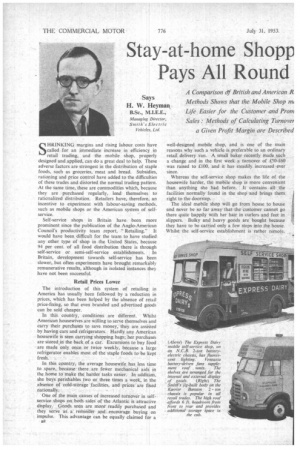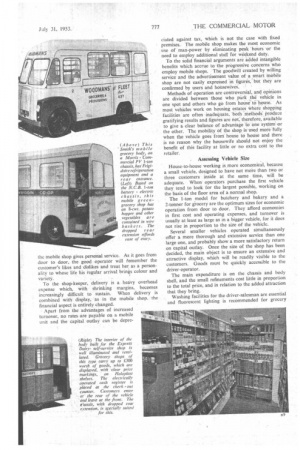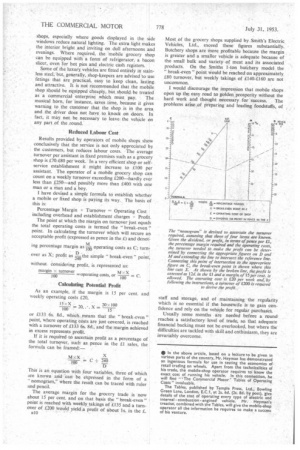Stay-at-home Shopp Pays All Round
Page 42

Page 43

Page 44

If you've noticed an error in this article please click here to report it so we can fix it.
SHRINKING margins and rising labour costs have called for an immediate increase in efficiency in retail trading, and the mobile shop, properly designed and applied, can do a great deal to help. These adverse factors are strongest in the distribution of staple foods, such as groceries, meat and bread. Subsidies, rationing and price control have added to the difficulties of these trades and distorted the normal trading pattern. At the same time, these are commodities which, because they are purchased regularly, lend themselves to rationalized distribution. Retailers have, therefore, an incentive to experiment with labour-saving methods. such as mobile shops or the American system of self
service. .
Self-service shops in Britain have been more prominent since the publication of the Anglo-American Council's productivity team report, "Retailing." It would have been difficult for the team to have studied any other type of shop in the United States; because 94 per cent. of all food distribution there is through self-service or semi-self-service establishments. In Britain, development towards self-service has been slower, but often experiments have brought remarkably remunerative results, although in isolated instances they have not been successful.
Retail Prices Lower
The introduction of this system of retailing in America has usually been followed by a reduction in prices, which has been helped by the absence of retail price-fixing, so that even branded and advertised goods can be sold cheaper.
In this country, conditions are different. Whilst American housewives are willing to serve themselves and carry their purchases to save money, they are assisted by having cars and refrigerators. Hardly any American housewife is seen carrying shopping bags; her purchases are stored in the back of a car. Excursions to buy food are made only once or twice weekly, because a large refrigerator enables most of the staple foods to be kept fresh.
In this country, the average housewife has less time to spare, because there are fewer mechanical aids in the home to make the harder tasks easier. In addition, she buys perishables two or three times a week, in The absence of cold-storage facilities, and prices are fixed nationally.
One of the main causes of increased turnover in selfservice shops on both sides of the Atlantic is attractive display. Goods seen are more readily purchased and they serve as a'. reminder and encourage buying on impulse. This advantage can be equally claimed for a
B8
well-designed mobile shop, and is one of the main reasons why 'such a vehicle is preferable to an ordinary retail delivery van. A small baker recently made such a change and in the first week a turnover of £50-£60 was raised to £100. and it has steadily increased ever since.
Whereas the self-service shop makes the life of the housewife harder, the mobile shop is more convenient than anything she had before. It contains all the facilities normally found in the shop and brings them right to the doorstep.
The ideal mobile shop will go from house to house and never be so far away thatthe customer cannot go there quite happily with her hair in curlers and feet in slippers. Bulky and heavy goods arc bought because they have to be carried only a few steps into the house. Whilst the self-service establishment is rather remote,
the mobile shop gives personal service. As it goes from door to door, the good operator will temember the customer's likes and dislikes and treat her, as a personality to whose life his regular arrival brings colour and variety.
To the shop-keeper, delivery is a heavy overhead expense which, with shrinking margins, becomes increasingly difficult to sustain. When delivery is combined with display, as in the mobile shop. the financial aspect is entirely changed.
Apart from the advantages of increased turnover, no rates are payable on a mobile unit and the capital outlay can be depre dated against tax, which is not the case with fixed premises. The mobile shop makes the most economic use of man-power by eliminating peak 'hours or the need to employ additional staff for weekend duty.
To the solid financial arguments are added intangible benefits which accrue to the progressive concerns who employ mobile shops. The goodwill created by willing service and the advertisement value of a smart mobile shop are not easily expressed 'in figures, but they are confirmed by users and housewives.
Methods of operation are controversial, and opinions are divided between those who park the vehicle in one spot and others who go from house to 'house. As most vehicles work on housing estates Where shopping facilities are often inadequate, 'both methodsl produce gratifying results and figures are not; therefore, available to give a clear balance of advantage to one system or the other. The mobility of the shop is used more fully when the vehicle goes from house to house and there is no reason why the housewife should not enjoy the benefit of this facility at little or no extra cost to the retailer.
. Assessing Vehicle Size • House-to-house working is more economical, because a small vehicle, designed to have not rndre than two or three customers inside at the same time, will be adequate. When operators purchase the first vehicle they tend to look for the largest possible, working on the basis of the floor area of a normal shop.
The 1-ton model for butchery and bakery and a 2-tonner for irocery are the optimum sizes for economic operation from door to door. They afford economies in first cost and operating expenses, and turnover is usually at least as large as in a bigger vehicle, for it does not rise in proportion to the size of the vehicle.
Several smaller vehicles operated simultaneously offer a more thorough and extensive service than one large one, and probably show a more satisfactory return on capital outlay. Once the size of the shop has been decided, the main object is to ensure an extensive and attractive display, which will be readily visible to the customers. Goods must be quickly accessible to the driver-operator.
The main expenditure is on the chassis and body shell, and the small refinements cost little in proportion to the total price, and in relation to the added attraction that they bring.
Washing facilities for the driver-salesman are essential and fluorescent lighting is recommended for grocery
shops, especially where goods displayed in the side windows reduce natural lighting. The extra light makes the interior bright and inviting on dull afternoons and evenings. Where required, the -mobile grocery shop can be equipped with a form of refrigerator, a bacon slicer, oven for hot pies and electric cash registers.
Some of the luxury vehicles are fitted entirely in stainless steel, but, generally, shop-keepers are advised to use fittings that are practical, easy to keep clean, lasting and attractive. It is not recommended that the mobile shop should be equipped cheaply, but should be treated as a commercial enterprise which must pay. The musical horn, for instance, saves time, because it gives warning to the customer that the shop is in the area and the driver does not have to knock on doors. In fact, it may not be necessary to leave the vehicle on any part of the round.
Reduced Labour Cost
Results provided by operators of mobile shops show conclusively that the service is not only appreciated by the customers, but reduces labour costs. The average turnover per assistant in fixed premises such as a grocery shop is ram per week. In a very efficient shop or selfservice establishment it might increase to £100 per assistant. The operator of a mobile grocery shop can count on a weekly turnover exceeding £200—hardly ever less than £250—and possibly more than £400 with one man or a man and i boy.
I have devised a simple formula to establish whether a mobile or fixed shop is paying its way.. The basis of this is: Percentage Margin X Turnover = Operating Cost including overhead and establishment charges Profit.
The point at which the margin on turnover just equals the total operating costs is termed the "break-even " point. In calculating the turnover which will secure an acceptable profit (expressed as pence in the £) and denoting percentage margin as —100 operating costs as C; turn. over as X; profit as 240 the simple " break-even " point, without considering profit, is represented as: margin x turnoverM x X =operating costs, or --C.
100 100
Calculating Potential Profit
As an example, if the margin is 15 per cent. and weekly operating costs £20, 15xX 20x100 20 X 100 • ' 15 or £133 6s. 8d., which means that the "break-even ", point, where operating costs are just covered, is reached with a turnover of £133 6s. 8d.; and the margin achieved in excess represents profit.
If it is required to ascertain profit as a percentage of the total turnover, such as pence in the £1 sales, the formula can be framed:— This is an equation with four variables, three of which are known and can be expressed in the form of a " nomogram," where the result can be traced with ruler and pencil.
The average margin for the grocery trade is now about 15 per cent. and on that basis the " break-even " point is reached with weekly takings of £135 and a turnover of £200 would yield a profit of about Is. in the f.. Most of the grocery shops supplied by Smith's Electric Vehicles, Ltd., exceed these figures substantially. Butchery shops are more profitable because the margin is greater and a smaller vehicle is adequate because of the small bulk and variety of meat and its associated products. On the Smiths 1-ton butchery model the
break-even "point would be reached on approximately £80 turnover, but weekly takings of £140-£160 are not uncommon.
I would discourage the impression that mobile shops open up the easy road to golden prosperity without the hard work and thought necessary for success. The problems arise of preparing and loading foodstuffs, of
The "nomogram" is devised to ascertain the turnover required, assuming that three of four items are known. Given the dividend, or profit, in terms of pence per
the percentage margin required and the operating costs, the turnover needed to make the profit can be determined by connecting the appropriate figures on D and M and extending the line to intersect the reference line. Connecting this point of intersection to the appropriate figure on C, the break-even point is shown where this line cuts X. As shown by the broken line, the profit is assessed at 12d. in the £1 and a margin of 15 per cent. is allowed. The ooerating cost is £20 per week and, by following the instructions, a turnover of £200 is required
staff and storage, and of maintaining the regularity which is so essential if the housewife is to gain confidence and rely on the vehicle for regular purchaset Usually some months are needed before a round reaches a satisfactory level of trade, so that adequate financial backing must not be overlooked, but where the' difficulties are tackled with skill and enthusiasm, they are invariably overcome.




















































































